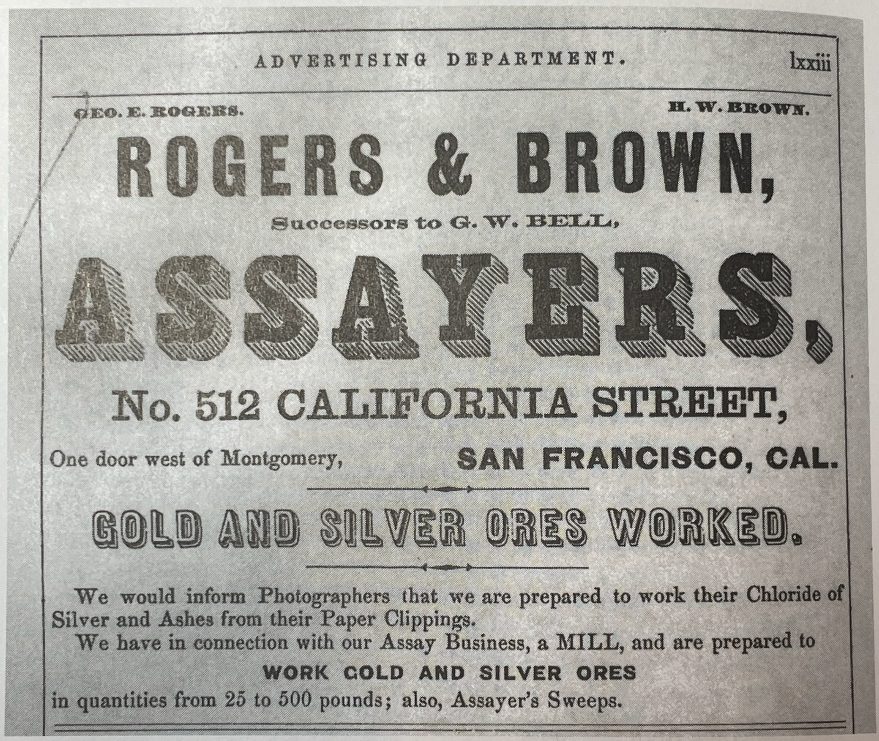The firm of Rogers & Brown, Assayers, located at No. 512 California Street, one door west of Montgomery Street, San Francisco, California, was the successor to the firm operated by G.W. Bell (who was killed in an explosion in 1866) and operated from the same location.
On April 16, 1866, the Daily Evening Bulletin ran an article, “Terrible Calamity” on page 5, which noted, in part:
One of the most terrible calamities that ever occurred in San Francisco — explosions so powerful as to shake the earth like an earthquake — caused by combustion of a case of nitro glycerine which had been brought to Wells Fargo . . . Mr. Bell was in the act of taking a horse from the stable to the rear of the building.
And, so, he met his demise.
In 1867 the Pacific Coast Directory noted that the firm of Rogers & Brown, Assayers, was the successor to G.W. Bell and was located in the same office.
An advertisement in the Pacific Coast Directory for 1867 noted: “Gold and Silver Ores Worked. We would inform Photographers that we are prepared to work their Chloride of Silver and Ashes from their Paper Clippings. We have in connection with our Assay Business, a Mill, and are prepared to work gold and silver ores in quantities from 25 to 500 pounds; also Assayer’s Sweeps.”
Alta California, April 29, 1866:
BELL’s ASSAY OFFICE.
The undersigned having purchased the above Assay Office, would inform the former patrons and the public generally that they will continue the assay business, in all of its branches, at the old stand, 512 California Street, one door west of Montgomery Street, with the same employees, under the name of Sanderson & Co. Mr. Edward Wolleb, for the last seven years assayer for Mr. Bell, will have charge of the Assay Department. The Melting Department will be under the charge of Mr. Henry J. Fisher, for ten years in the United States Mint in this city and Philadelphia, and for the past seven years with Mr. Bell…. Mr. George E. Rogers, for the past two years with Mr. Bell, will have general charge of the business.

Above is an advertisement for Rogers & Brown Assayers in the Daily Alta circa 1867.
The book “California Coiners and Assayers” by Dan Owens covers four important pages of history on this Assayer in chapter 38, p349-352. The ingot is also featured on a couple of pages in the book “John J. Ford, Jr. and the FRANKLIN HOARD” by Karl Moulton.
1.02 oz Rogers & Brown, Assayers, San Francisco, Gold Bar, c1867


A rectangular ingot as illustrated, containing .095 parts silver and .898 gold. Serially numbered 1425. Inscriptions by various prepared and single punches, as shown. The logotype for the company name, ROGERS & BROWN, was double punched with the result that the imprint is likewise doubled.
An important piece of 19th-century Americana.
This is the only ingot stamped Rogers & Brown and has direct ties to John J. Ford provenance–it represents the top echelon of collectible fantasy ingots that pertain to John J. Ford, who likely didn’t know at the time that a (real) ingot from George E. Rogers would later surface as described here: https://rareingot.com/george-e-rogers-assayer/.
Obtained from John J Ford, Jr. in 1972, from Paul Franklin.
[02/1982] https://archive.org/details/henryhcliffordco1982bowe/page/n69/
[06/1997] https://nnp.wustl.edu/library/auctionlots?AucCoId=3&AuctionId=516717
